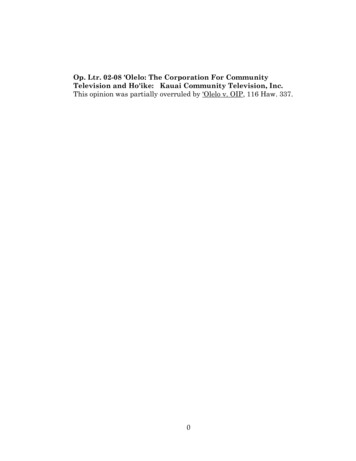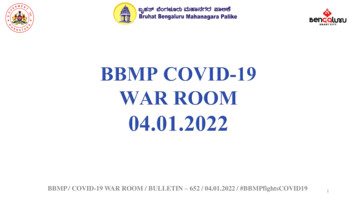
Transcription
Op. Ltr. 02-08 'Olelo: The Corporation For CommunityTelevision and Ho'ike: Kauai Community Television, Inc.This opinion was partially overruled by ‘Olelo v. OIP, 116 Haw. 337.0
September 6, 2002Ms. Wendy ArbeitPresidentThe Community TelevisionProducers AssociationP.O. Box 23296Honolulu, Hawaii 96823Ms. Carol D. BainPresidentKauai League of Women VotersP.O. Box 1181Lihue, Hawaii 96766Re:‘Olelo: The Corporation For Community Television andHo’ike: Kauai Community Television, Inc.Dear Ms. Arbeit and Ms. Bain:In 1998, The Community Television Producers Association (“CTPA”),represented by Wendy Arbeit, asked the Office of Information Practices(“OIP”) to determine whether ‘Olelo: The Corporation for CommunityTelevision (“’Olelo”) is a state agency or a quasi public body. In 2001, TheLeague of Women Voters of Kauai, represented by Carol D. Bain, asked theOIP to reconsider its opinion that Ho’ike: Kauai Community Television, Inc.(“Ho’ike”) is not subject to the requirements of the Uniform InformationPractices Act (Modified), chapter 92F, Hawaii Revised Statutes (“UIPA”).Additionally, The League of Women Voters of Kauai asked the OIP whetherHo’ike is subject to the Open Meetings Law, chapter 92, Hawaii RevisedStatutes. This second issue regarding Ho’ike will be addressed separately.1
ISSUE PRESENTEDWhether ‘Olelo and Ho’ike are subject to the requirements of the UIPA.BRIEF ANSWERYes. The Director (“Director”) of the Department of Commerce andConsumer Affairs (“DCCA”) has required, as the local franchising authority,the cable franchisee to set aside public, educational and governmental accesschannels (“PEG access channels”). A review of the totality of circumstancesindicates that both ‘Olelo and Ho’ike were originally created by the DCCA,notwithstanding their current corporate form, and are funded almost entirelythrough funds allocated pursuant to the Director’s authority under theHawaii Cable Communications Systems Law, chapter 440G, Hawaii RevisedStatutes (1993) (“HCCSL”).The OIP concludes that although the DCCA has not exercised closecontrol over the administration of the PEG access channels, the DCCA doeshave significant and direct control over ‘Olelo and Ho’ike through itsappointment and removal power of the majority of appointees on the boardsof those corporations. The OIP concludes that the DCCA exercises indirectcontrol over the existence of ‘Olelo and Ho’ike through the contractualagreements designating both as the Director’s designee and terminating theircorporate existence when that designee status ends.Finally, the OIP concludes that the DCCA performs a governmentfunction by providing for PEG access channels and that the administration ofsuch channels, but not editorial control over the public portion of PEG accesschannels, is a government function performed by ‘Olelo and Ho’ike by or onbehalf of the DCCA.Examining the totality of all the factors, the OIP is of the opinion that‘Olelo and Ho’ike are corporations owned, operated, or managed by or onbehalf of this State as set forth under section 92F-3 of the Hawaii RevisedStatutes, and are, therefore, required to follow the UIPA. To the extent thatthis opinion is in conflict with OIP Op. Ltrs. No. 93-18, No. 94-23, and No.94-24, those opinions are rescinded by this opinion.2
FACTSIn 1970, the State of Hawaii enacted the HCCSL, amending it severaltimes through the 1980s. Under State 1 and federal 2 authority, the Directorof the DCCA authorizes cable system franchises for each county. TheDirector has issued, by way of Decisions and Orders (“D&Os”), 3 cablefranchises to certain entities (“Cable Operators”) 4 at various times 5 to operatecable1Haw. Rev. Stat. §§ 440G-4(a) and 440G-8(a) (1993).2Clyde S. Sonobe, DCCA’s Cable Television Administrator, advised the OIP in a letterdated May 10, 2002, that the authority under which the DCCA operates includes 47 U.S.C.S. §§522(10), 541(a)(1) and 542 (2002).Cable television originated because of the need to reach communities unable to receivetelevision signals because of distance or terrain. Ed Foley, Comment: The First Amendment as Shieldand Sword: Content Control of PEG Access Cable Television, 27 Cap. U.L. Rev. 961, 963 (1999). In hisComment, Mr. Foley notes that as the cable television system (“CATV”) grew, local broadcastersbecame concerned about the incursion of cable into their market share and applied pressure on theFederal Communications Commission (“FCC”) to regulate this new media. Id. The FCC assertedjurisdiction over CATV operations, preventing the CATVs from importing signals into the top 100markets and issued rules requiring the cable operators to create programs themselves, not simplyretransmit broadcast signals. Two years later, the FCC eliminated the local origination requirementsand required certain cable operators to reserve four channels for four types of third-party access:leased, public, educational and governmental programming. Leased channels were for those whowished to purchase a time slot generally for profit. The remaining channels, public, educational andgovernment (“PEG channels”) could not sell advertising or engage in commercial acts. The FCCintended that PEG channels provide a forum where citizens could “participate in community dialogue.”The FCC thus required the operator to provide non-discriminatory access on a first-come, first-servedbasis free of charge. Id. at 964.In 1979, the United States Supreme Court struck down the FCC’s mandatory access rules,ruling that they were beyond the FCC’s power under the Communications Act. Id. In 1984, Congresspassed the Cable Communications Policy Act of 1984 (“CCPA”). Public access channels were consideredby Congress to be the “video equivalent of the speaker’s soap box or the electronic parallel to theprinted leaflet.” Id. at n. 54. Under the CCPA, the local franchising authority could require the cableoperator to set aside public access channels under arrangements set out by the local franchisingauthority. However, under the federal law, the cable operator was prohibited from exercising anyeditorial control over the public access channels and was absolved of any civil or criminal liabilityresulting from programming carried on those channels. Id. at 967.3The Director has the power to issue D&Os pursuant to sections 440G-3, Definitions;440G-7, Cable franchise application or proposal procedure; public hearing; notice; 440G-8.1,Requirement for adequate service; terms and conditions of service; and 440G-12(a), Other duties ofdirector; suit to enforce chapter, of the Hawaii Revised Statutes. The Director has issued D&Osauthorizing the initial cable franchises and amended such franchise terms and conditions withsubsequent, non-sequential D&Os.4In 1996, the U.S. Supreme Court issued Denver Area EducationalTelecommunications Consortium v. FCC, 518 U.S. 727, 116 S. Ct. 2374 (1996) (“Denver Area”). In thatcase, the Court explained that:3
systems including the laying of cable along public places and easements. 6These D&Os note that such franchisees derive economic benefit from such anauthorization. 7 Under the HCCSL, the Director has significant power toattach terms and conditions to the cable franchise. 8 Under State law, theCable Operators must set aside channels for PEG use. 9 The United StatesSupreme Court has stated that:[p]ublic, educational, or governmental channels’ . . . are channelsthat, over the years, local governments have required cablesystem operators to set aside for public, educational, orgovernmental purposes as part of the consideration an operatorgives in return for permission to install cables under city streetsand to use public rights-of-way.Denver Area Educational Telecommunications Consortium v. FCC, 518 U.S.727, 116 S. Ct. 2374 (1996) (“Denver Area”). State law 10 authorizes theDCCA to require support of PEG access under federal and State law, and hasimposed that obligation, as well as others, via D&Os upon the CableCable operators typically own a physical cable network used to conveyprogramming over several dozen cable channels into subscribers’ houses.Program sources vary from channel to channel. Most channels carryprogramming produced by independent firms, . . . as well as someprogramming that the system operator itself (or an operator affiliate)may provide. Other channels may simply retransmit through cable thesignals of over-the-air broadcast stations. [Citation omitted.] Certainspecial channels here at issue, called “leased channels” and “public,educational or governmental channels,” carry programs provided bythose to whom the law gives special cable system access rights.518 U.S. at 733-34.In 1994, Hawaii had seven independent cable companies. Following a period ofacquisition or exchange of cable systems Hawaii ended up with two Cable Operators: for the island ofKauai, G Force, L.L.C. dba Garden Isle Communications, and for the remainder of the State, thepredecessor to the current authorized franchisee, TWE-AOL Time Warner Inc. D&O No. 261 at 5-6,(Aug. 11, 2000). Just recently, TWE-AOL Time Warner Inc. acquired all cable franchises in the Stateof Hawaii under D&O No. 291 (July 12, 2002) when the Director granted the transfer of the two cablefranchises for the island of Kauai to Time-Warner Entertainment Company, L.P.56Haw. Rev. Stat. § 440G-8.2(a) (1993).7D&Os No. 261, § II, C at 5, (Aug. 11, 2000); No. 255, § II, C at 5,(Aug. 30, 2000).8§ 440G-8(d).9§ 440G-8.2(f).10§§ 440G-6(b)(5), 440G-8.2(f), 440G-4 and 440G-12(e) (Supp. 2001).4
Operators. 11 Pursuant to these cable franchises, and through specificcontracts tied to the D&Os, entities were formed for the specific purpose ofadministering PEG access channels across the state (“PEG AccessOrganizations”). 12DISCUSSIONI.STANDARD FOR RECONSIDERATION OF PRIOR OPINIONSThe OIP has previously issued opinions regarding the application ofthe UIPA to Akaku – Maui Community Television, Inc., 13 Ho’ike 14 and NaLeo O’ Hawaii, Inc. 15 The request to revisit the issue of whether Ho’ike issubject to the UIPA, and the new issue of whether ‘Olelo is subject to theUIPA, raises the question of what standard the OIP will follow when asked torevisit an issue settled in previous OIP opinions. The OIP thereforeexamines appellate court standards for reconsideration of a specific ruling,and for overruling prior decisions, as a guide.The standard used by courts for reconsidering a conclusion of law isthat the appealing party must show the findings of fact are clearly erroneousor the conclusions of law are incorrect. Child Support Enforcement Agency v.Jane Roe, 96 Haw. 1, 13, 25 P.3d 60, 72 (2001) (citation omitted). Thestandard for overruling a settled precedent, or stare decisis, is “compellingjustification.” Hilton v. S. Carolina Pub. Rys. Cmsn., 502 U.S. 197, 202, 112S. Ct. 560, 565 (1991).In three instances, the OIP has reconsidered prior opinions. Althoughno standard for reconsideration was cited to, the specific reasons forreconsideration in those opinions were a change in the law in two cases 16 and11D&Os No. 135, Terms and Conditions § 5.4(d) at 12, (Nov. 30, 1988); No. 138, Termsand Conditions of Order No. 138, § 6.4 at 15, (July 16, 1990).12See infra Section II, B.1 of this opinion for a discussion of the formation of Ho’ike and‘Olelo, DCCA’s designated PEG Access Organizations.13OIP Op. Ltr. No. 93-18 (Oct. 20, 1993).14OIP Op. Ltr. No. 94-23 (Dec. 13, 1994).15OIP Op. Ltr. No. 94-24 (Dec. 13, 1994).16OIP Op. Ltrs. No. 95-17 (July 18, 1995) (reconsidering OIP Op. Ltr. No. 95-5 (Mar. 5,1995)); No. 97-07 (July 18, 1997) (reconsidering OIP Op. Ltr. No. 89-8 (Nov. 20, 1989)).5
a change in the facts in the third. 17 Based on prior OIP practice and oncourt standards, the OIP will reconsider a prior opinion when at least one ofthe following is present: (1) change in the law, (2) change in the facts, or (3)other compelling circumstances.In the requests before us, it is clear that the OIP has been providedwith an abundance of facts that substantially changes the context in whichthe prior opinions were issued, and therefore, the OIP will reconsider the OIPOpinion Letter Number 94-23, on Ho’ike.II.REQUIREMENTS OF THE UIPAA.Accountability Through Access to RecordsWhen interpreting the UIPA, the OIP is required to apply and construethe chapter to promote its underlying purposes and policies. One of thosepolicies is to “enhance governmental accountability through a general policyof access to government records; . . .” Haw. Rev. Stat. § 92F-2 (1993).The legislature declared that “[i]t is the policy of this State that theformation and conduct of public policy – the discussions, deliberations,decisions, and action of government agencies – shall be conducted as openlyas possible.” Id. To enforce this policy, the legislature has requiredgovernment agencies to “make government records available for inspectionand copying during regular business hours.” Haw. Rev. Stat. § 92F-11(b).However, the UIPA applies only to the inspection and copying of "governmentrecords" and, under the law, “[g]overnment record means informationmaintained by an agency in written, auditory, visual, electronic, or otherphysical form." Haw. Rev. Stat. § 92F-3 (emphasis added). The term"agency" is defined by the UIPA as:any unit of government in this State, any county, or combinationof counties; department; institution; board; commission; district;council; bureau; office; governing authority; otherinstrumentality of state or county government; or corporationor other establishment owned, operated, or managed byor on behalf of this State or any county, . . .Id. (emphasis added).171990)).OIP Op. Ltr. No. 99-05 (Oct. 19, 1999) (reconsidering OIP Op. Ltr. No. 90-20 (June 12,6
Quite often, the issue of accountability is raised when either agovernment agency has been “privatized” or an entity is so intertwined withgovernment that the public perceives that entity to be engaged ingovernmental action. In either event, the issue of accountability is raised.The question of who is accountable to the public underlies the issue raised bythe requesters of this opinion.In this instance, The League of Women Voters of Kauai alleged in itsrequest to the OIP that “a continuing movement away from part 1, Chapter92 “Sunshine Law” provisions by the Ho’ike board of Directors is apparent.In recent months the board has systematically stripped major elements ofopen governance and Sunshine from the Ho’ike By Laws.” 18The CTPA, through Ms. Arbeit, claims to have sought documents from‘Olelo and been denied access to “detailed fiscal reports.” In its 1998testimony to the Senate Committee on Commerce, Consumer Protection andInformation Technology on S.C.R. No. 51 and S.R. 18, the CTPA detailed itsfrustration with ‘Olelo and alleged that the legislature should require a thirdparty to do a fiscal and operational audit of ‘Olelo and alleged that an inhouse audit would do nothing but enable ‘Olelo to “continue misappropriatingpublic resources and curtailing the public’s First Amendment rights.” 19Thus, both requesters indicate their inability to obtain informationfrom ‘Olelo and Ho’ike, and their frustration with the way in which theseentities deal with issues of accountability. The requesters are asking that‘Olelo and Ho’ike be accountable to the public by asserting that ‘Olelo andHo’ike are government agencies, and thus subject to the public records andSunshine laws.B.Corporation Owned, Operated, Managed By or On Behalfof This StateThe issue before the OIP is whether ‘Olelo and Ho’ike are subject to theUIPA by virtue of the definition of “agency.” In 1990, the OIP had occasion tointerpret and apply section 92F-3 of the Hawaii Revised Statutes, to the18Letter from Carol Bain, President of The League of Women Voters of Kauai, to theOIP of Sept. 13, 2001, at 1.19Testimony of Wendy Arbeit, CTPA President, to the Hawaii State Legislature, SenateCommittee on Commerce, Consumer Protection and Information Technology on S.C.R. No. 51 and S.R.18 on March 18, 1998.7
Hawaiian Humane Society. In that opinion, the OIP said:Although this definition of agency presents little difficulty whenapplied to such organizations as executive branch departments,boards, and commissions, its application becomes difficult whena UIPA request is directed either to a hybrid organization thatbears only some characteristics of a state or local agency, or anentity that is not commonly perceived as a governmentagency.OIP Op. Ltr. No. 90-31, at 5 (Oct. 25, 1990) (emphasis added). In applyingthis definition of “agency” to the Hawaiian Humane Society, the OIPreviewed the legislative history of the UIPA, looked for guidance to thecommentary accompanying the Uniform Information Practices Code, uponwhich the UIPA was based, 20 reviewed federal interpretation of section 552(f)of the Freedom of Information Act, and state court interpretations of statepublic records laws. The OIP concluded that the decision as to whether anentity is subject to the UIPA must be determined on a case-by-case basis andmust be based upon a review of the totality of circumstances. 21 However, itwas clear that an entity is not “operated on behalf of” the State or anycounty . . . merely [because it contracts] with a government agency. 22Nonetheless, the OIP declined to follow the federal approach of requiring dayto-day control of the entity’s operations by the government agency andconcluded that such a constrictive approach to the broader definition ofH. R. Stand. Comm. Rep. No. 342-88, 14th Leg., 1988 Reg. Sess., reprinted in Haw. H.J. 969, 972 (Haw. 1988). The definition of “agency,” as set in the Uniform Information Practices Code,includes the same language as set out in section 92F-3 of the Hawaii Revised Statutes except that theModel Code excludes the legislature or courts of the state from the definition of “agency”. Thecommentary to the section states:20The definition of the term “agency” in Section 1-105(2) is intended to becomprehensive. Consistent with much existing public record legislation,it includes all units of state and local government ranging from thelargest to the one-person office. . . . It also includes any combination ofpolitical subdivisions of state or local government and any corporation orother establishment operated on behalf of the state or any politicalsubdivision.Uniform Information Practices Code §1-105(2) Cmt. At 8 (1980). (emphasis added) (citations omitted)21OIP Op. Ltr. No. 90-31, at 14 (Oct. 25, 1990).22Id.8
agency found in the UIPA would be contrary to the legislative intent behindthe statute. 23In the OIP Opinion Letter Number 94-5, (whether the Villages ofKapolei Association was a government agency) the OIP set forth the elementsit would review to determine whether an entity is an establishment owned,operated, or managed by or on behalf of this State or any county. The OIPwrote:in determining whether a nonprofit corporation is an "agency"for purposes of the UIPA, it is necessary to examinethe totality of circumstances surrounding the operation of thecorporation. Such an examination should include aconsideration of whether the corporation performs agovernmental function, the level of governmentalfunding, the extent of governmental regulation orcontrol, and whether the entity was created by thegovernment.Id. at 1 (emphasis added).Three of these elements of the UIPA test were used by the U. S.Supreme Court in Lebron v. National Railroad Passenger Corp., 513 U.S.374, (1995), to determine that Amtrak was, for purposes of individual rights,a governmental entity. Despite the fact that Congress had deemed Amtrak tonot be a government agency, the United States Supreme Court noted:[t]hat Government-created and -controlled corporations are (formany purposes at least) part of the Government itself has astrong basis, not merely in past practice and understanding, butin reason itself. It surely cannot be that government, state orfederal, is able to evade the most solemn obligations impo
Sep 02, 2002 · 5 In 1994, Hawaii had seven independent cable companies. Following a period of acquisition or exchange of cable systems Hawaii ended up with two Cable Operators: for the island of Kauai, G Force, L.L.C. dba Garden Isl











